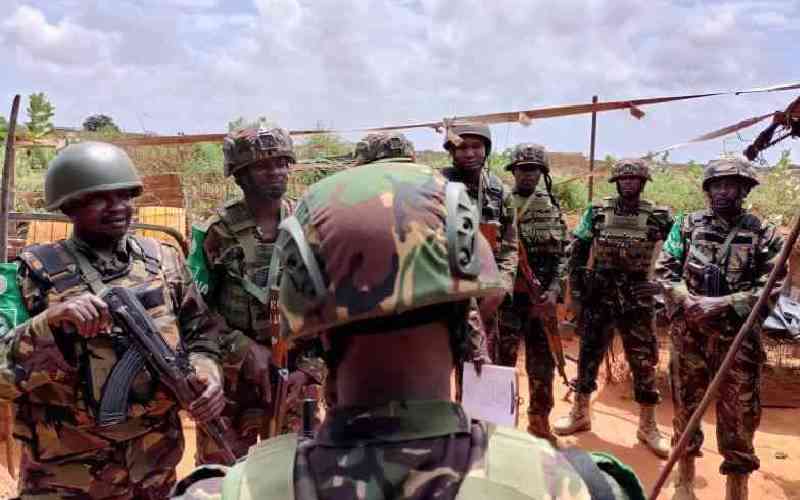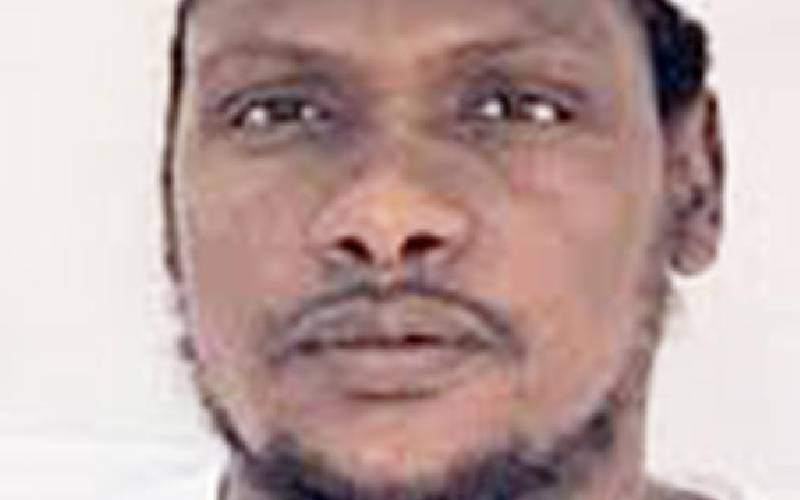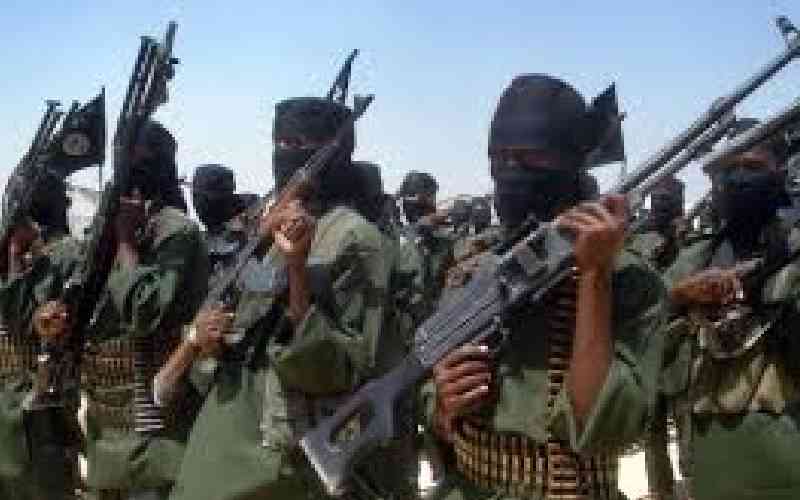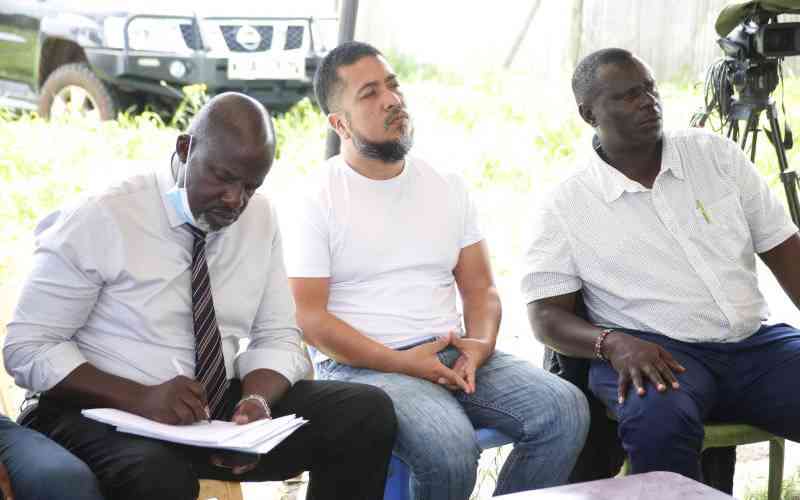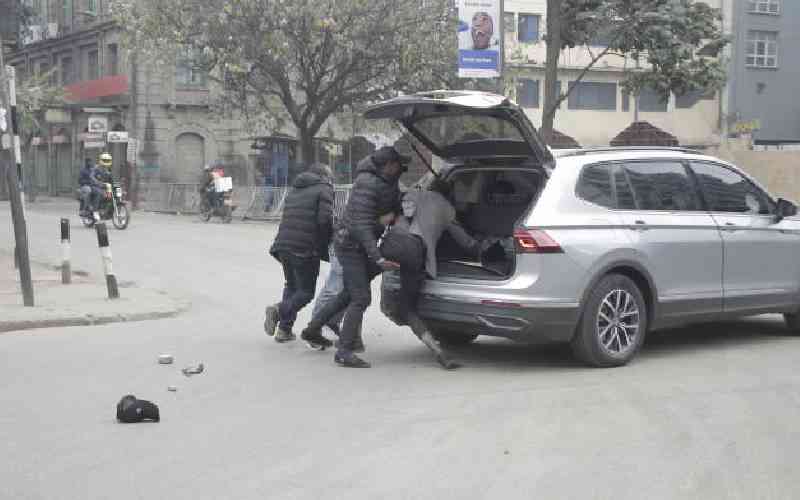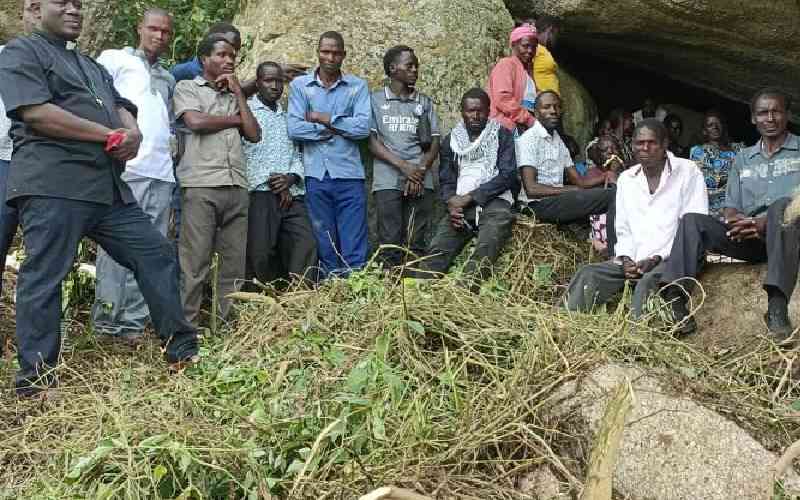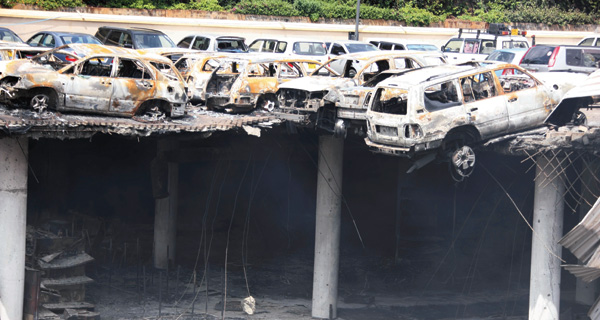 |
|
Scenes of the collapsed parking floors of the Westgate Mall and shells of burnt cars following the attack |
By Nyambega Gisesa and Cyrus Ombati
Details emerged showing how terrorists planned their heinous plot that unravelled at the Westgate Mall where over 60 people were killed during a four-day siege.
Reports suggest that the terrorists might have crossed over from Somalia, the base of the Al-Qaeda linked Al-Shabaab militant group, which has since claimed responsibility for the attack.
The gunmen are believed to have had a shop at the upscale shopping complex, where they masqueraded as businessmen, while using it as a haven to conceal some of the weaponry sneaked in over time.
A Turkish national who reportedly rented out his shop to “suspicious characters” at the Mall is among dozens of people interrogated by police.
The terrorists, who executed the midmorning Saturday raid and who Kenyan authorities estimated between 10 and 15, are thought to have spent a considerable amount of time rehearsing their atrocious plan.
The New York Times reported the plot was hatched weeks or months ago on Somali soil, by the Al Shabaab’s ‘external operations arm’.
Having secured a shop inside the mall, the terrorists and their accomplices had enough time to survey the building.
Police are investigating reports that some people visited City Hall’s Planning Department prior to the attack to obtain building plans for the mall.
They are investigating the possibility that their accomplices obtained the building’s blueprints to help in planning the attack by identifying key landmarks.
Little wonder that when they struck, the terrorists seemed to know even the most secluded places that offered them perfect cover. The terrorists were stationed at the most strategic places of the building — a sniper at the rooftop, another sniper on the second floor and another one at the ground floor.
Reports indicate the attackers also took cover in ventilation ducts, forcing commanders to instruct the Kenya Defence Forces soldiers to bring down all ventilation outlets. This was after hostile shots from the ducts wounded several KDF men.
The terrorists also stormed the building through the front door, basement and rooftop, meaning that they knew all the possible outlets.
Prior to the attack, to maintain their surveillance within the neighbourhood, investigators believe the terrorists put up in one of the residential houses in the area.
Suppliers of various goods and services who served the residential houses are being tracked down to help in profiling the attackers.
Stay informed. Subscribe to our newsletter
“We are following various clues on where these people are believed to have lived near the mall. We are moving well and want to know all the tenants near there and anyone who supplied food and other services to them,” said an officer involved in the probe but who declined to be named as he discussed a national security matter.
With their heinous plan complete, it was time to strike their target. The upscale shopping mall was a pricey target for the terrorists because residents of affluent neighbourhoods flocked it and also it was popular among expatriates. Therefore, it presented high chances of netting high profile victims.
Indeed, President Uhuru Kenyatta’s nephew, Mbugua Mwangi, and his fiancée, Rosemary Muthoni, were killed in the attack.
The President’s niece, a university don, sustained serious gunshot wounds. Three other close relatives, including his sister, were among those rescued.
The gunmen felled leading Ghanaian writer Prof Kofi Awoonor of the popular statement “Death has made war upon our house”.
But it was not just about picking the target, but also getting the timing of the attack right. By striking mid-morning on Saturday when most shoppers flock shopping malls, the terrorists intended to inflict high casualties.
With an official death toll of 67 including six security agents (Red Cross reported 69 and 71 missing), add to reports more bodies are buried in the rubble, over 200 injured and 1,000 rescued, and their ill-plan was ripe.
FORCED THEIR WAY THROUGH
The attackers, estimated at between 10 and 15, split themselves into two gangs. This enabled them to launch a multi-pronged attack on the shopping complex. The terrorists attacked the mall from the basement, front door and from the roof-top, killing as many people as possible.
A review of CCTV cameras at the mall reveals that the gunmen gained entry from the front and rear side of the building through the parking yard. The attackers pulled up at the shopping complex at about 11.30am in three vehicles and refused to have their cars inspected by Securex guards contracted to offer security at the building. They moved to the parking lot with the guards in tow. The Securex guards made a call to Parklands Police Station asking for help. They also sought the help of the Head of Security at the mall, Maurice Adembesa, to resolve the impasse. Adembesa, carrying a walkie-talkie, walked towards the vehicles but the attackers sprayed him with bullets.
They then came out of their cars and started shooting at people indiscriminately.
“We heard gunshots and thought that it was a normal robbery,” said Mr Ben Mulwa, a politician who survived the attack. “I saw four gunmen shooting at everyone.”
Mulwa says that the gunmen wore a head cap known as keffiyeh in Arabic, a favourite of former Palestinian leader Yasser Arafat. The attackers were carrying rifles, sub-machine guns, and small backpacks.
The first gang attacked a café at the entrance of the mall. They shot indiscriminately and hurled grenades. While inside the building, the terrorists first targeted Urban and Gourmet Burgers.
“The bullets went through my arms then blood started oozing,” Arnold Nicholas, 22, a waiter at the shop recalls. The other gang of four stormed the mall’s parking yard using the main parking entrance.
They then walked upstairs through the ramp to the upper floor where the Radio Africa Group’s East FM hosted a cooking contest. At the rooftop, they shot at poor kids. CCTV footage shows two attackers shooting at the crowd that included women and children and hurling two grenades. One exploded. Police later collected the unexploded one.
Earlier at the parking yard, they had killed a pregnant woman who tried to argue with them. They were seen pointing guns at people at close range while shouting. According to Raisah Viranah, 15, she saw six of the terrorists who shot at anyone who looked at them in the eye. The men were wearing jeans and t-shirts, one with an Arabic headscarf wrapped around his head. They had pistols sticking out of pockets and were carrying huge guns.
Mr Bernard Wambua of Radio Africa Group says that he saw a white woman leading the attack. The woman shot at people scampering for safety. Believed to be the “White Widow”, Samantha Lewthwaite, she is said to have pointed out targets. With her gun, she shot at a gas cylinder at the venue of the East FM-organised cooking competition for children, resulting in a small fire. She also shot at several microwaves. On Thursday, Interpol issued a Red Notice at the request of Kenya, seeking the capture of Lewthwaite. Interpol circulated the images of the woman on its website requesting public assistance to capture her. An Interpol Red Notice, or internationally wanted persons alert, asking member states to arrest the wanted suspects, represents one of the organisation’s most powerful tools in tracking down international fugitives.
The terrorists shot at anyone who screamed. The gang that burst through the front moved upstairs to the first floor as their accomplices, who had accessed the building through the rear doors, also came down. The first floor hosts a food court that was busy at the time. The gunmen shot terrified people from the back as they fled. The attackers are captured on footage firing at doors of washrooms to take out those seeking refuge there. The gunmen then retreated into the supermarket as a lull fell, preparing for a confrontation with Kenyan security forces.
ORDINARY ROBBERY
With the shooting intensifying, various units from the National Police Service namely Flying Squad, Special Crimes Unit and Administration Police responded. The first police officers, nine in number, entered the building mistaking the attack for normal robbery.
Lower Kabete police chief Stephen Lelei, who coordinated the initial operation, was injured at about 2.28pm and a fellow policeman shot dead.
A British off-duty SAS officer who was in the mall at the time killed two of the terrorists.
Over an hour later at about 4pm, police made the first attempt to advance into the building. They were forced to retreat after facing heavy gunfire.
Word had by then gone out that authorities were dealing with a bigger crisis. The military was assembling a team from Lang’ata Barracks, the Maroon Commandos, 75 Artillery battalion men based in Embakasi and men from the Moi Airbase in Eastleigh.
Away from Nairobi, a more deadly force of Kenya’s Special Operators was on standby. KDF’s elite units, 40 Ranger Strike Force, 30 Special Forces and 20 Parachute Battalion, arrived at the mall on Saturday at 2pm armed with two types of combat rifles, the American M4 combat, the US Army's primary individual combat rifle for Infantry, Ranger and Special Operations forces that allows its user to better operate in close quarters combat, and FN Scar rifle, another Special Operations Forces Combat Assault Rifle.
CCTV FOOTAGE
Police sought the help of Securex, the security firm, to try and find out if they could access the closed circuit cameras.
They said it was not possible but they sought the help of a hacker anyway. They accessed the first footage of the men who took over Westgate.
Photos and videos in our possession reveal two attackers walking inside Nakumatt Supermarket in black headgears carrying guns and bags of ammunition.
In another photo, there are another two terrorists, with one having his head completely uncovered.
The man in black shoes, a white sagging trouser and black jacket with bullet magazines strapped all over his abdomen, has a gun on his right hand as he flashes a finger salute. His fellow attacker, who also had sagging jeans, has a bullet magazine belt and is carrying an AK-47 rifle.
These are part of the terrorists who killed innocent people using bullets, explosives and cut the hands and legs of some of them and then sent them down the escalators to a waiting team of rescuers.
MULTI-AGENCY ASSAULT
On Sunday, the terrorists moved from room to room in the mall looking for hostages to kill.
Without having given any demands, security agencies decided to carry out a multi-agency assault involving combined elite forces so as to rescue the hostages.
“We thought that we were to walk in and come out,” a soldier told us as he drank milk to “wash” heavy smoke inhaled from the mall.
This was the failed “final assault” that ended with 10 KDF men injured and three terrorists killed.
By Sunday evening, both the police and military had claimed that they had taken control of the CCTV surveillance system of the building.
“We now have control of the CCTV system and comms (communication) of the building,” KDF Public Information Officer Colonel Cyrus Oguna said on TV on Sunday evening.
Kenyan security agencies also claimed to have secured the first and second floors of the mall after “forcing the terrorists to run towards the third and fourth floors,” as one official put it.
However this was far from the truth.
For the better part of Monday, the military and the terrorists engaged in a heavy exchange of fire. At about 1.30pm, the first huge blast was heard from the building, sending emergency units, police and media scampering for safety.
Earlier on Monday morning a sniper had killed three KDF soldiers.
The heavy blast was followed by sustained heavy gunfire as hostages screamed for help. Four hours later, there was persistent gunfire from various sections of the mall.
“When the KDF men pushed into the building, one of the terrorists blew himself up, leading to a huge fire that caught parts of the building especially the supermarket. The terrorists then started burning mattresses and throwing them to lower floors resulting in a heavy smoke.
It’s the explosions and huge smoke that the Internal Security Minister Joseph Ole Lenku said was as a result of “terrorists burning mattresses.”
After some time, the roof and parts of the supermarket caught fire and began caving in, trapping the hostages under burning debris. Two floors made from wood also came down.
“We received a call that we go and put out the fire,” a Nairobi City Council firefighter told The Standard. “We feared for our lives but the soldiers assured us of our security.”
The firefighter says that he heard several women wailing as a result of the smoke.
“They continued screaming for help even as we left after putting out the fire,” he told us.
By Monday evening, the troops had surrounded the basement, first, second and the last floor of the mall. “However the heavy smoke forced us to retreat,” one of the soldiers told The Standard.
THE FINAL ATTACK
By the end of Monday, security agencies had made a decision on collateral damage.
During the evening, all vehicles belonging to security agencies, emergency units and the fire brigade were moved further from the mall for the most important and most dangerous attack since the siege started.
As early as 3am, the troops marked out for the final attack got into top gear, rehearsing the assault that started a few minutes before 6am when they stormed the mall for a final attack.
Entry was through multiple points, including a section of the wall that the 75 Artillery men brought down.
A sniper who shot dead some of the terrorists, described it the toughest job of his life. “I waited and waited for hours to locate the snipers who had killed and injured my colleagues,” said the soldier.
The attackers were armed with weapons, explosives and ammunitions enough to hold off an army unit. One of the KDF units carried over 10,000 bullets from their armoury.
The identity of the terrorists still remains a mystery that forensics examination currently on-going might hopefully solve. However, the powerful response to about 10 to 20 terrorists holding Kenya’s best trained security agencies for three good days paints the picture of men trained to die while being the last men standing.
In a briefing, the Chief of the Kenya Defence Forces General Julius Karangi said international terror suspects had masterminded the attack.
Interviews with emergency response units, military and police personnel and the people who survived the massacre point at a well-organised, well-equipped, well-rehearsed and a suicidal terror gang that burnt even their own killed in the four-day siege so as to hide their identity.
“How they possibly obtained such kind of rifles I cannot know but I am certain that they are not the kind of weapons you carry across the streets on the day of attack,” the KDF sniper says.
As early as 7.08am, about an hour after the start of the assault, KDF had taken over 1st, 2nd and 3rd floors.
By 8.45am, KDF was yet to take control of the fourth floor. The fight lasted for another one-and-a-half hours until KDF took control of the entire battle-scarred building. Various types of weaponry including rocket propelled grenades (RPGs) and the 84mm anti-armour anti-tank weapon system, a true multi-role, man-portable shoulder-fired weapon was deployed for the attack.
Details of the terror plot emerged amid reports that the Israelis had warned Kenyan authorities that militants planned attacks on their key interests in the country.
The terror alert reportedly was relayed to the Ministry of Foreign Affairs as late as September 13, a week to the attack on Westgate shopping complex.
“The Israeli Embassy in Nairobi has raised concern with the Ministry of Foreign Affairs of Kenya over possible terrorist attacks on their citizens during the Jewish Holidays period between 4th to 28th September 2013, by Iran and the Hezbollah whom they accused of collecting operational intelligence and open interests in Israeli and Jewish targets around the World including Kenya,” reads the situation report.
An earlier assessment of threats in 2011 had identified shopping complexes, including Westgate Mall and Holy Family Basilica, as possible targets of terrorist attacks.
It named Sheikh Abdiwelli Mohamed, Sheikh Hussein and Sheikh Hassan as the masterminds of the plot. They are believed to be in possession of two suicide vests, 12 hand grenades and two AK-47 rifles, and have already surveyed the two targets. They are being assisted by Sheikh Hassan alias Blackie of Majengo and Omar Ahmed Ali alias Jerry who are currently staying near Mamba Petrol Station and Huruma Mosque along Juja Road.
A situation report dated February 1, 2013, warned of “Mumbai-attack style”, where the operatives storm into a building with guns and grenades and probably hold hostages.”
It is on the basis of the intelligence reports that the National Intelligence Service reportedly communicated the threat to relevant agencies, according to the report.
However, the NIS action could not be independently verified.
The report claims briefs were made to the National Security Council members informing them of increasing threat of terrorism and of plans to launch simultaneous attacks in Nairobi and Mombasa on 13th and 20th September, 2013.
([email protected] and [email protected])
 The Standard Group Plc is a
multi-media organization with investments in media platforms spanning newspaper
print operations, television, radio broadcasting, digital and online services. The
Standard Group is recognized as a leading multi-media house in Kenya with a key
influence in matters of national and international interest.
The Standard Group Plc is a
multi-media organization with investments in media platforms spanning newspaper
print operations, television, radio broadcasting, digital and online services. The
Standard Group is recognized as a leading multi-media house in Kenya with a key
influence in matters of national and international interest.
 The Standard Group Plc is a
multi-media organization with investments in media platforms spanning newspaper
print operations, television, radio broadcasting, digital and online services. The
Standard Group is recognized as a leading multi-media house in Kenya with a key
influence in matters of national and international interest.
The Standard Group Plc is a
multi-media organization with investments in media platforms spanning newspaper
print operations, television, radio broadcasting, digital and online services. The
Standard Group is recognized as a leading multi-media house in Kenya with a key
influence in matters of national and international interest.



